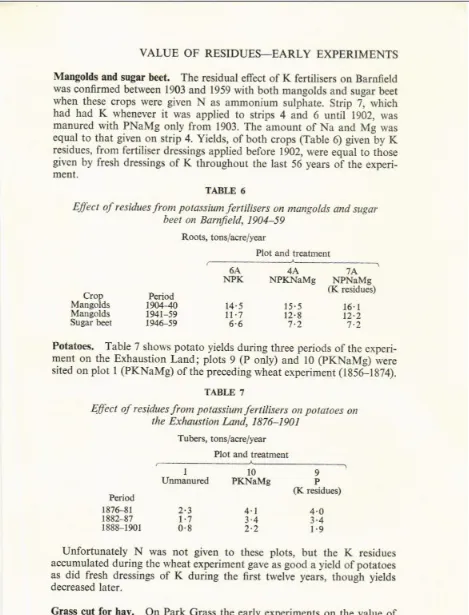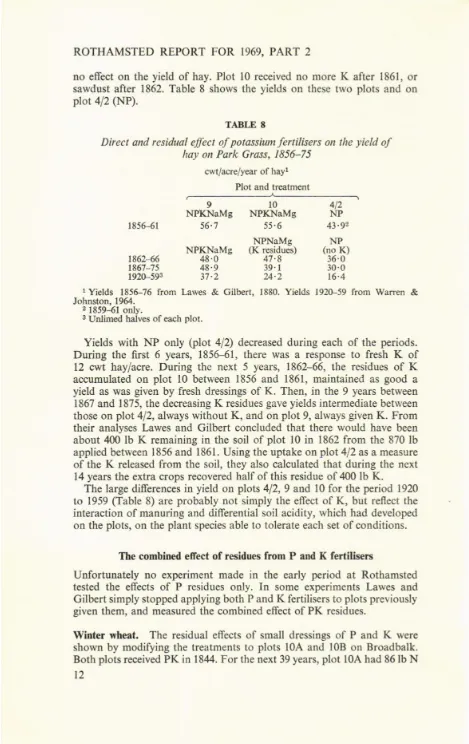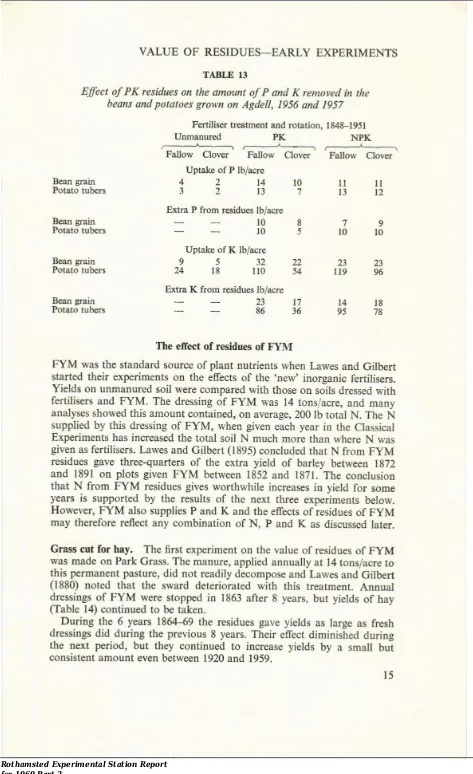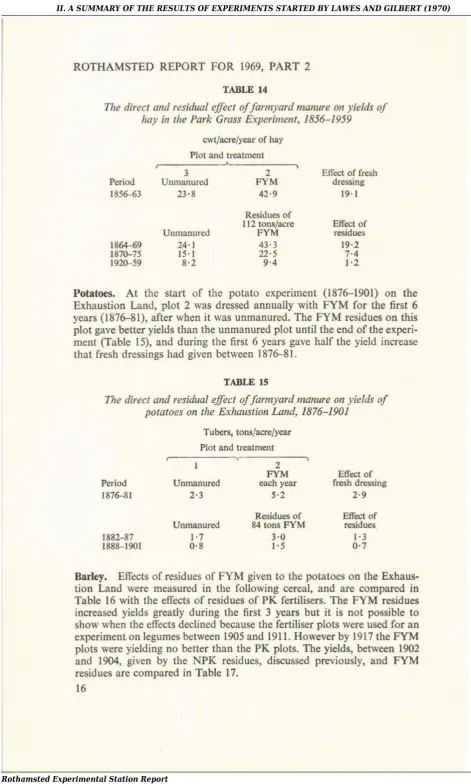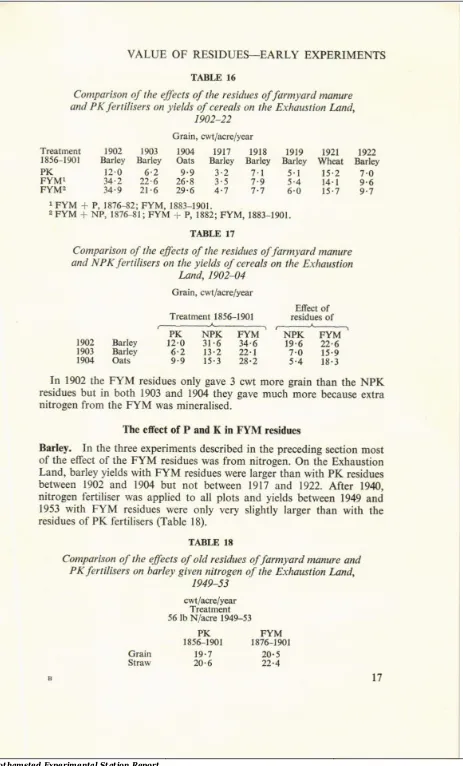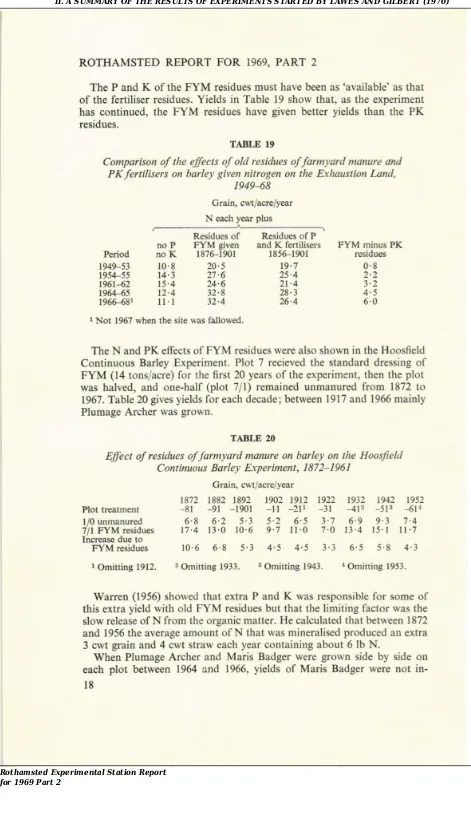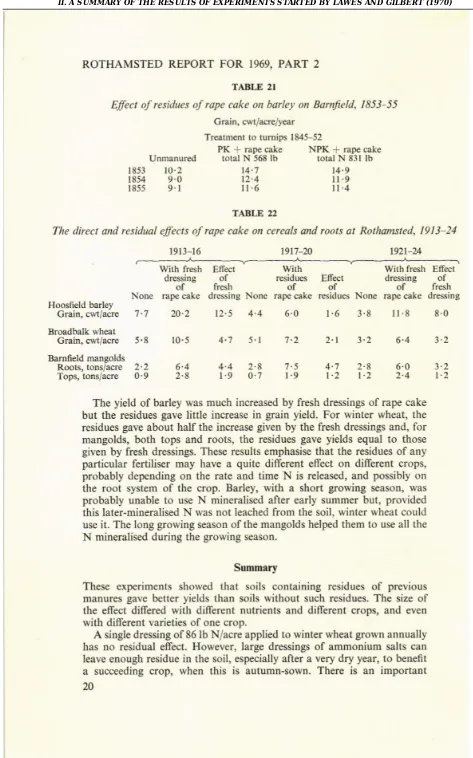Rothamsted Experimental
Station Report for 1969 Part
2
Full Table of Content
Ii. A Summary of the Results of Experiments Started by
Lawes and Gilbert
A. E. Johnston
Ii. A Summary of the Results of Experiments Started by Lawes and Gilbert , A. E. Johnston (1970) Rothamsted
Experimental Station Report For 1969 Part 2, pp 7 - 21 - DOI: https://doi.org/10.23637/ERADOC-1-34861
The
Valueof
Residuesfrom
Long-period Manuring
at
Rothrmsted
andWobun
II.
A
Srmmary of
theRes
tsof
Experimen8 Started
by Lawes and
Gilbert
A.
E.
JOHNSTONLawes and
Gilbert
made many testsof
the valueof
residuesof
fertilisers and manures accumulatedin
soilduring
the long-periodof
manuringin
their
exp€riments, and later,Hall
made somefurther
tests. Someof
these testsstill
contilrue. The results, summarised here, werefrom
modificationsmade
in
thefollowing
experiments:Agdeu.
Tbis
+course
rotation
experiment,
started
in
1848,
wasdescribed by Warren (1958) and more briefly
otpage24,
Bail{uu.
Yarious experiments onroot
crops were madefrom
1843to
1959 detailsof
which were given by Warren andJohston
(1962).Broadbalk.
Detailsofthe
treatmentsto
the winter wheat were givenby
Johnston and Garner (1969).
Exhatstion
Larul,
Thoughmainly
cereals have been grown, there wasa manurial experiment
with
potatoes grown continuouslyfrom
1876to
1901.
The history
of
the
site was describedby
Warren
and Johnston(1960) and more briefly
on
page 23.floosfultl
ContinuousBuley.
Warreraand
Johnston (1967) gave the detailsof
the treatmentsto
the barley grown on this site since 1852.Park Grass.
This experiment, startedin
1856to
study the manuringof
permanent meadow cut twice each year,
for
hay and laterfor
aftermath,rvas described by Warren and Johnston (1964).
Permaunt
llhest
ard
Buley
Experimen*
a
llobwn.
The
designof
these experiments started
in
1876 by the RoyalAgricultural
Society wasinfluenced by Lawes and Gilbert. The exp€riments have been conducted from Rothamsted since I 926 when the management of the Woburn Farm
became the responsibility
of
the LawesAgricultural Trust.
The historyof
the sites is described on page 25.The efrect of resftlues of nitrogen fertilisers
Winter
wteat: rormal
dressingsof N.
Before
1852 l,awesand Gilbert
had showed
that
a single dressingof
inorgaDicN
to
the srinter wheaton
Broadbalk had
little
residualefect
on thefollowing crop of
winter wheatresidual efects
of
PKNaMg,
was made onplots
17 andl8
and wascon-tinued
until
1967.Plot
17
received86
lbN/acre
in
even
years, andPKNaMg
fertilisers in odd years, andplot l8
rec€ivedN in
odd years andPKNaMg
in
even years.Table
I
shows meanyields (Garner
&
Dyke,TABLE
I
Efect
of
the residuesoffertiliser N
andPKNaMg
on winter whea,on Broadbalk, I
I
5 2-1 967c*tlaqelyat
Plot aod treatment
5
PKNaMg anaually
t7ltg
PKNaMg
Srven
N residues
8'2
13.0t7118
N
gtveo
PKNaMg
residues 16.8
29.7
lo7
N
NPKNaMsaouually
annuallyt2-6
17.1m.4
*.2
Graitr
8.9Straw
14.01969)
on
theseplots
over
the
whole
period
1852-1967.There
was no residual effectof N.
Theyield
on
plots
1/18
with
residualN
\yasonly
equal
to
that
on plot 5
givenPKNaMg
annually
but no
N.
However,Table
I
also shows there wasa very
large residual effectof
PKNaMg,
because yields on plotsl/18
withN
almost equalled those onplot
7, givenNPKNaMg
each year.WiDter wheats largg dressings
of
N.
Winter
wheatgrown on
plot
16 onBroadbalk during
the
l860s showedanother
interesting residual effect.From
1852to
1864 annual manuring onplot
16 wasNPKNaMg,
supplying 172lb
N/acre.The
two
seasons, 1863and
1864,both
favoured wheatand
there waslittle
extra gain
from
increasingN
from
129to
172lb.
Lawes andGilbert
(1884) stopped applying fertilis€rsto plot
16in
t865 but, over the next 19 years, they recorded the yields, which are comparedwith
thoseof
plot
5, givenPKNaMg but not
N
every yearin
Table 2.Lawes and
Gilbert
thoughtthat
the very largeefect
of
the residuesin
1865, half the directefect
ofthe
172lb
N in
1863-64, wasfrom
ammonia remainingin
the soil,
for
1864 was the driest yeaxin
the
then recordedhistory of
the experiment. The 2to
3
cwt increasein
grain yield over thenext three years
they
decided was causedby
extra nitrogen released by mineralisationof
the largerplant
residuesin
the soil
of plot t6
than in
plot
5. After l868, the readily mineralisableN
had gone and yields were no b€tter than those onplot
5.Barley
aftcr
tmnils
and
swedes.After
turnips and
swedeshad
beengrown on Barnfield
for
ten years, Lawes andGilbert
grew barleywithout
manure
in
1853, 1854and
1855.The
yieldsin
Table 3from
Lawes andGilbert 0857)
confirmedtheir
often repeated statementthat
good yieldsrequired 'available nitrogen
within
the
soil'.
Residuesfrom
the NPK
given
to
thetumips
gave a small (1.5 cwt) extrayield of
grainin
eachof
VALUE OF RESIDUES-EARLY
EXPERIMENTS
TABI,E 2
Direct and residual
efect of
172 lbfertiliser N
on winter whedt on Broadbalk, 1863-83Grain, c$,t/aqr/y.ar
Plot aDd treatEent
Year 1863 lE64 5 PKNaMg anaually
I
l.l
9.3 PKNaMg annually 7.2 4.9 9.9
l6
NPKNaMg aDnuallv includine !72Ib N/aqe3l.t
28.8 Unmanured 17.8 9.5 12.8Efrect of
t72 Ib N
20.0 19.5
Eff€ct of
N ,esiducs
l0.r
2.3 2.8 0.3-o.2
-o'7
1865r 866
1867 1868 Period 1869-73 187+78 1879-83 8.7 6.7 6.9 8.4 6.9 7.6
the
tfue
years.How
small
was emphasisedin 1854
when,
on
part
of
!!e
_lvalley'
plots
with the
sameP
and
K
residuesas
the main
plots,82
lb
N/acre was given, which increased yieldby
17.8 cwt grain.TABI,E 3
Efect
of residues from fertilisery givenlo
roots on thefield
of
barley on Barnfiekl,l85j-55
Grain, cEt/acre/year
Treitment to tu.rips 1845-52
1853
t854
1855
Unmanurcd
PKlo.2
t0.69.0
9.69.1
9.6Trcatment to barley 82 lb N/acre in 1854 only
26.8 t2-7
263 lblaqe
ll.8
10.4 10.3
Barley
after
Intato€s,
From
l9Q2to
1940 unmanured cereals followed thepotato
experiment on the Exhaustion Land. Table 4 shows the yieldsof
cereals, which were measured onall
plots
onlyin
thefirst
three years and againfrom
l9l7
to
1922. Between 1856 andl90l
amual
dressingsof
86lb N/aoe
weregiven,l4
times.In
1902,yield
after potatoes manuredwith
eitherN
or
NPK
was much larger than after potatoes unmanuredor
given
only
PK.
However,the
smaller cropson
the
N
only than
on
theNPK
plotsleft
smaller residues and the effectof
these disappearedin
twoyears. On the
NPK
plots mineralisationof N
gave small increasesin
yieldfor
some yearsbut
theefect
disappearedby
l9l9-22.
TABIT
4Efect
of
residues fromfertiliser
dressings on the yieldof
unmanured cereals on the ExhdustionInnd,
1902-22Graid, cwt/ac.e/year
Tl€atsnent 1856 to l90l
Year t902 1903 1904 t9t7 l9l8 1919 19211 t922 Crop Turnips Swedes Swedes NP (KNaMg rEsiftr€s)
SrEdes
l85l-70
5'0I The qop6 of 1859 and 1860 failed.
At
fust
(1845-48) there was no respolxeto
IC
Iater,
however, becauseof
the gradual depletionof
soilK
where none was given as fertilis€r, there wasa
response and giving freshK
increasedyield
by
l'1
tons/acre/year between 1856and
1858.On
plot 4A
the mean annual dressingof
100lb
K/acre as fertiliser between 1845 and 1860 was more than that removed
in
the tops androots; the
residuethat
accumulatedin
the soil during
thisperiod
maintaineda
yield
of
l'0
ton
roots/aqe
morethan
on
Plot
5A during the next ten years,l86l-70.
10
Crop
UnmanuredBarley
16'6Barley
6'0Oats
10.8Barley
3'2
Barley
4'5Barley
2'8Wheat
8'l
Barley
6'4PK
NPK12.0
3r.65.2
13.29-9
15.33.2
5.57.r
9.65.1
5.015.2
14.41.0
7.8Urrmanurcd 1.2 N
D.4
9.1tt.2
3.0 6.6 3.6ll.6
7.8 Pr 6.9
6.4 10.9 3.0 6.9 15.7 7.5
r The 1920 crop failed.
The efiect
of
residues from potassium fertilisersResidues
ol
potassium manures were measured itrfour
exp€riments'Swedes.
In
the experimentwith
swedes on Barnfield,K
wasnot
applied between 186l and 1870to
plots givenK
betwe€n 1845 and 1860. Table 5shows mean yields
for four
periodsfor
the crops givenN
as ammonium sulphate.TABLE 5
D
ect dnd residualefect
of potassm
fertilisers on turnips, and swede s, Bamfi e ld, I 845-70Root$, tons/acre/year
4A
Period
NPKNaMg18498
9.8lu9-s2
9.4l85c58r
6.55A
3A or 8ANP
UDmatruted9.9
1.48-7
3.85.4
1.7NP
(tro K) 4.0
VALUE OF
RESIDUES_EARLY
EXPERIMENTS
Mengolls
and sugarbeet
The residual eflectof
K
fertilisers on Barnfieldwas confirmed between 1903 and 1959
with
both mangolds and sugar beetwhen these crops were given
N
as ammonium sulphate.Strip 7,
\yhichhad had
K
wheneverit
was appliedto
strips4
and
6
until-
1902, wasmanured
with
PNaMg only
from
1903. The amountof Na
andMg
wasequal
to that
given on strip 4. Yields,of both
crops (Table 6) given byK
residues,
lrom
fertiliser dressings applied before 1902, were equalto
thosegiven
by
fresh dressingsof
K
tkoughout
the last 56 yearsoi
the experi-menl.TABLE 5
Efect
of residuesfrom
potdssiumfertilisers
on mangolds and sugar beet on Bamfield, 1904-59Roots, toos/acre/year
4A
7ANPKNaMg
NPNaMg(K iesidues)
6A
NPK
14.5
t5
5
t6.l
lt.1
12.8
12.26.6
1.2
7.2Potsto€s.
Table 7 shows potato yields during three periodsofthe
experi-menton
the ExhaustionLand;
plots 9(P only) and
l0
@KNaMg)
weresited on
plot
I
(PKNaMg)
of the preceding wheat experiment (185G1874).Crop
PeriodMangolds
1904-40Margolds
1941-59Sugar
beet
1946-59TABIT
7Efect
of residtusfrom
potdssiumferrilise$
on polotoes on the Exhaustionl-otd,
1876-1901TubeN, tons/acre/year
Plot and treatrnql
I
UDmanuredPeriod
l87c8l
2.31882-87
1.71888-1901
0.8109
PKNaMg
P(K residues)
4-l
3.4 2-24.O
3-4 1.9
Unfortunately
N
was
not
given
to
theseplots,
but the
K
residuesacrumulated during the wheat experiment gave as good a yield
olpotatoes
as
did
fresh dressingsof
K
during the
first
twelve years,though
yieldsdecreased later.
Grass cut
for
hay.
On Park Grass the early experiments on the valueof
residues
of
manurial dressings werenot
complicated bymajor
changesin
botanical
composition, aswere many
of
the
comparisonsof
manurial treatment on yield. Plots 9 andl0
recejved the same manures(NpKNaMg)
between 1856
and
1861, excepttbat
plot
10 alsogot
sawdust,which
badll
no
effecton
theyield
of
hay.Plot
l0
receivedno
moreK
after
1861,or
sawdustaft€r
1862. Table 8 shows the yieldson
thesetwo plots
and onplot
4/2 (NP).TABLE 8
Direct and residual
efect
of poldssium fertilisers on the yieldof
hay on
Park
Grass, 1856-75cwtlacre/year of hay!
Plot and treatment
9
l0
412NPKNaMg
MKNaMg
NP1856{1
56.1
55.6
43-9.NpKNaMg
cl*'IfoY*l
,"Y",
t8624
48.0
47.8
36.01867-75 ,r8.9
39.1
10.0t920-593 37.2
24-2
16.4I Yields 1856-76 from Lal{es
&
Gilbert, 1880, Yields 1920-59 from Warrcn&
Johnstor, 1964.
, 1859-61 or y.
s Uolimed halvcs of each plot.
Yields
with
NP
orly
(plot
4/2)
decreasedduring
eachof
the periods.During
the
first
6
years,185fu1,
there wasa
responseto
fresh
K
of
12
oxt
haylaqe.
During the next 5
years, 1862-66,the
residuesof K
accumulated
on
plot
l0
between 1856and
1861, maintained asgood
ayield as was given by fresh dressings
of
K.
Then,in
the 9 years between 1867 and 1875, the decreasingK
residues gave yields intermediate between those onplot
4/2, alwayswithout
K,
and on ptot 9, always givenK.
Fromtheir
analyses Lawes andGilbert
concludedthat
therewould
have beenabout 400
lb
K
remainingin
thesoil
of
plot l0
in
1862from
the 870lb
applied between 1856 and 1861. Using the uptake on plot 4/2 as a measure
of
theK
releasedfrom
the soil, they also calculatedthat during
the next 14 years the extra crops recovered halfof
this residue of 400lb K.
The large diferences
in
yieldon
plots 412,9 and 10for
theperiod
1920to
1959(table
8) are probablynot
simply the effectof K,
but
reflect theinteraction
of
manuring and differential soil acidity, which had developedon the plots, on the plant species able
to
tolerate each setofconditions.
The combimd efiect of residues fmm
P
andK
fertilisersUnfortunately
no
experiment madein
the
early period
at
Rothamstedtested
the
effectsof
P
residuesonly.
In
some experiments I-awes andGilb€rt simply stopped applying both P and
K
fertilisers to plots previouslygiven them, and measured the combined etrect
of PK
residues.Winter
wteet
The residual effectsof
small dressingsof
Pand
K were
shown by
modifying
the treatmentsto plots
l0A
andl0B
on
Broadbalk.Both plots received PK
in
18.t4. For the Dext 39 years,plot
l0A
had 86 lbN
VALUE OF RESIDUES-EARLY
EXPERIMENTS
annually, whereas
l0B
hadtwo
more dressingsof
P andK
(in
18,18 and 1850) followed by 33 yearswith
86lb
N
annually. Table 9(from
Lawes&
Gilbert,
1884) gives yieldsfor four
8-year periods.TADIJ
9Efect
of PK residues on$inter
wheat on Broadbalk, 1852-83Grain, cwt/acre/year
l0B
Treatment
PK in18,14
PKh
18.t4, 1848, & 1850 39 years Nonly
then 33 years N onlyThe residues
from
60lb
P and 240lb K
produced, whenN
was alsogiven,
a
mean aDnualyield
increaseof
2.4and
1.7cwt
grainin
thefust
and second 8-year periods,
but
afterthat their
efects diminished rapidly.Barley.
Beginning
in
l94l
the
barley
on
the
Exhaustion
Land
wasmanured annually
with
N.
Yields were
takenfrom
1949,and
averagesfor
thefirst
5 yearswith
N
at
56lb N/affe
arein
Table 10. Even after 50 years the residuesof
theP
andK
applied between 1856and
l90l
gave,when
N
was given, an extra 9cwt
grain.That
these residues hadsuih
agood effect after such a long time is,
no doubt,
becauseN
wasnot
given between_1901 and l94O and the yieldsofthe
cereals grown, and the uptakesof
P andK,
were small.In
this experiment, though the effect as meisuredwas that
of
P plusK,
Warren (1956) concluded from analysesof
the cropsthat the increase
in
yield was mainlyfrom
the P residues.TAIILE 10
Efect
ofPK
residues on barley whenN
wasgivm
on the E x haustion Land, I 9 49-5 3cwt/acre/ycar
TEatme
(othet than N)No Pno
K
Pr
PK18.4
t9-7t9.l
20-61 PK, 185G75; P, l876_t90t.
lYintet wteat
rd
badeyat
Wobun.
In
1959and
1960 thesetwo
crops,given basal
N,
weregrown on
everyplot
of
the
permanentWheat
andBarley Sites
at
Woburn, last
manuredwith
P and
K
in
1926.Table 1l
shows yields, as averages
of all
plotswith
appropriate treatments.l3
Period
1852-59
t8@-61
I E6E,75 1876 83
It.8
12.4 9.8 8.5
14.2 14.l 10.4 9.4
Efect of PK
r€sidues
(l0B midus l0A) 2.4
t.7
0.6 0.9
10.8
12.7
Grain
Straw
TABLE 1I
Efect
of residues of PK Jertilisers andFYM
on vheat and barley on the Woburn Pemanent Wheat andBarley
Sites, 195940Grai4 cwt/a€re/y€a.
Treatmeots applied t877-1926
NoPnoK
Winter wheat
Wheat
Site
16-9Barley
Sire
U.9
Barleywh€at
Site
19.6Badey
Site
18.324.0 23.8
26.2 20.0 t8.2
19.2t4.4
8.6 155 l4.l
PK
FYM18.8
.824.3
28.024.1
21.5
Wheat yielded
better
on
theBarley
Sitethan
on
theWheat
Site and barley betteron
the Wheat Sitethan on
the Barley Site.To
what extent this reflected diflerencesin
disease orfertility
between thetwo
sites isnot
known.
In
sevenof
the
eight
comparisons,yields were
increased byresidues of PK accumulated between 1877 and 1926 from fertiliser or
FYM.
Be.ns anrl
potato€s.
These two crops, grown on Agdellin
1956 and 1957 respectively, valuedthe
combined effectof
the
accumulated residuesof
PK
fertiliser given
once every4
yearsduring
the
four-courserotation
experiment and last applied
in 1948.
Table 12 gives the yieldsoffield
beans,grown
without
addedN,
andof
potatoes, given basalN.
TABLE 12
Effect of residues of PK
ferlilisers
on beans dnd potdtoes on Agdell1956 dnd 1957
Fertiliser treatdrcnt ard rotatiotr 18,18-1951
Uomanued
PK
NPKFallow
Clover
Fallow
Clover
Fallow
Clover 1956 BeansGraitr
cwt/acre
85
5,21957 Potato€s
Total tubers
toos/acae
4.4
3.0The yields
of both
beans and potatoesfrom PK
residues were as goodas
from
many
well
manuredcrops
on
RothamstedFarm. The
mean increasesfrom
the
combined effectsof
P and
K
were 14cM/acre
bean grain and 8.5 tons/acreof
potatoes.In
five
of
the six comparisons, yields were smaller on plots where clover was grownin
therotation
while other plots were fallowed, because P andK
were removedin
the clover and less wasleft to
accumulatein
the soil.Warren (1958) showed
that
thetwo
crops differedlittle in
the amountof
P they tookfrom
the starved orfrom
the enriched soil, but the potatoestook up
moreK
than the beansfrom
the starved soil and much moreK
from
the enriched soil (Tablel3).
VALUE OF RESIDUES-EARLY
EXPERIMENTS
TABLE T3
Efect
ofPK
residues on the dmount of P and.K
removedin
the beans and potatoes grown onAgdell,
1956 and 1957Fqtiliser treatEreat aDd rotatioo, 1848-1951
UDmanued
PK
NPK-:-:---^=---'t
Fallow
Clove.
Fallow
Clover
Fallow
CloverUptake of P lb/acae
Bean
Sain
4
2Potato
tubers
3
2Bean grain Potato tubers
B€ao
Srairr
9
5Potato
tubeB
24
18Extra P f.oE r€sidues
lb/acr
10879
10510
10Uptake of K lb/acrc
14
l0
It
tl
t37t3t2
32
22
23
23ll0
54
ll9
9623
t7
14
l8
86
36
95
78 Exrra K from residues lb/ac.eBean graio
The eficct of residrcs of
FyM
FYM
was the standard source ofplant
nutrients \yhen Lawes andGilbert
started
their
experimentson
the effectsof
the 'new'
inorganic fertilisers.Yields on unmanured soil were compared
with
those on soils dressedwith
fertilisers
and
FYM.
The
dressingof FYM
was 14 tons/acre, and manyanalyses showed this amount contained, on average, 200 lb totat N. The
N
supplied by this dressing
of
FYM,
when given each yearin
the Classical Experiments has increased thetotal
soilN
much more than whereN
was given as fertilisers. Lawes and Gilbert (1895) concluded thatN from
FyM
residues gave three-quarters
of
the extra
yield
of
barley
between 1872and
l89l
on plots
givenFYM
between 1852and
1871.The
conclusionthat
N
from
FYM
residues givesworthwhile
increasesin
yieldfor
someyears
is
supportedby the
resultsof
the
next
tkee
experiments below.However,
FYM
also supplies P andK
and the effectsof
residuesof
FyM
may therefore reflect any combination
of
N,
P andK
as discussed later.Grass cut for
bay.
Thefirst
experiment on the valueof
residuesof
FyM
was made on Park Grass. The manure, applied annually
at
14 tons/acre to this permanent pasture,did not
readily decompose and La.\i,,es andGilbert
(1880)
noted
that
the
sward
deterioratedwith
this
rreatment. Annualdressings
of FYM
were stoppedin
1863after
8 years,but
yieldsof
hay(Table 14) continued
to
be taken.During the 6
years 1864-69the
residues gave yields as large as fresh dressingsdid during
the previous 8 years.Their
effect diminished duringthe
next period,
but
they
continuedto
increaseyields
by
a
small but
consistent amount even between 1920 and 1959.
TABI,E 14
The direct and residual efiect
offarmyard
manure on yieldsof
hay in thePark
Grass Experiment, 1856-1959c*.tlaqelyar ol l1ay Plot and treatrncnt
3
Period
Unmalured185G63
23.8UDmanured
t8&-49
24.11870-75
15.1t9x-59
4.242.9
Residucs of I 12 toos/acae
FYM 43.3
9.4
Eficct of fresh dressiag
t9.l
mect
of
rcsidues19.2 7-4 1.2
2
FYM
Potato€s.
At
the
start
of
the
potato
experiment (187G1901)on
theExhaustion
Land,
plot
2
was dressed annuallywith
FYM for
thefirst 6
years(l87c8l),
after whenit
was unmanured. TheFYM
residues oD this plot gave better yields than the unmanuredplot until
the end of theexperi-ment
(fable
l5),
andduring
thefirst
6 years gavehalf
the yield increasethat fresh dressings had given between
l87G8l.
TABLE 15
fie
direct and residualefect of farmyonl
tnanure on yielclsof
potdtoes on the ExhaustionInnd,
1876-1901Tubers, toos/acre/year
Plot and teatment
Period
t87
r1882-87 1888-1901
I
UnrnaDur€d
2-3
Unma.ourrd 1.7 0.8
FTM
each year
5.2
Effect of
frrsh dressing
2-9
Residues
of
mcct of84 toas
FYM
r€sidu€s3.0
I .3r.5
0,7Borley,
Effectsof
residuesof FYM
givento
the potatoes on theExhaus-tion Land
were measuredin
the following
cereal, and are comparedin
Table 16
with
the effectsof
residuesof
PK
fertilisers. TheFYM
residues increased yieldsgeatly
during
thefirst
3 yearsbut
it
is
not
possibleto
show when the effects declined because the fertilis€r plots were used
for
an experiment on legumes between 1905 andl9l l-
However byl9l7
theFYM
plots were yielding no better than the
PK
plots. The yields, between 1902and
1904, givenby
the
NPK
residues, discussed previously,and FYM
residues are compared in Table 17.VALUE OF
RESIDUES_EARLY
EXPERIMENTS
TABLE 15
Comparison
of
the efectsof
the rcsiduesof
farmyard manure and PKlertilisers
on yieldsof
cereals on the Exhaustion Land,1902_22
Grain, cwt/acre/year
Treatment
l9O2 l90l
t9O4
l9l7
1918
l9l9 l92t
19221856-1901
Badey
Bartey
Oars
Barley
Barley
Barley Wheat
BarleyPK
t2.O 6.2 9.9 3.2 7.1 5.r 15.2
7.OFYMI
34.2
22..6
26.8 3.5 7.9 5.4 14.1
9-6FYM'
34.9 21.6 29.6 4.7 7.7 6.0 t5.7
9.7 I FYM+
P, 1876 82; FYM, 1883-1901., FYM
+
NP, 187ffi1 ; FYM+
p, 1882;FyM,
1883_t901.TABIT 17
Comparison
ol
the efectsof
the residues of farmyard manure and NPK fertilisers on the yields of cereals on the ExhoustionLand,
190244
Grain, cM/acre/year
rreatmeot
tssGleol
#Tes{t
-NpK-
FrM-190.2
Barley
12.O
31.6 34.6 l9.d
D.6
1903
Barley 6.2
13.2
22.1 7.O
t5.91904
Oats
9.9
15.3
28.2 5.4
18.3In
1902 theFYM
residuesonly
gave 3cwt
moregain
than the
NpK
residues
but
in
both
1903and
190.1 they gave much more because extranitrogen
from
theFYM
was mineralised.Tte
efrectof
P,&l
K
inFfM resirtucs
Brrlen
In
the three experiments describedin
the preceding section mostof
the effectof
theFYM
residues wasfrom
nitrogen.On
the Exhaustion Land, barley yieldswith
FYM
residues were larger thanwith PK
residuesbetween 1902
and
l9O4but
not
betweenl9t7
and
1922.After
19$,
nitrogen fertiliser
was appliedto all
plots
and yields between 1949 and 1953with
FYM
residueswere
only
very slightly larger
than
with
theresidues
of PK fertilisen
(Tablel8).
TABIJ
lt
Comparison
of
the efects of old residues of farmyard manure ond PK fertilisers on barley given nitrogenof
the Exhaustion l-and,1949_53
Csttlaq.lyat
Tr€atmant
56 lb N/asre 1949-53
PK
FYMt85Gt90l
I87Gl90lGraiD
l9-7
2,-5Straw
X-6
22.4The P and
K
ofthe FYM
residues must haye beenas'available'as
thatof
thefertiliser
residues. Yieldsin
Table
19 showthat,
as the experimenthas continued,
the
FYM
residues have given better yieldsthan the PK
residues.
TABLE 19
Comparison
of
the efects of old residuesoffarmyard
mdnure dnd PKfertilisers
on barleygivet
nitrogen on the Exhaustion l-ond,194948
Grain, cM/acre/year
N each year plus
Period
1949-53 1954-55
l
t-4219ffi5
1966-68rResidues of
no
P
FYM givenoo
K
l87Gl9O!10.8
2n-514.3
21-6t5-4
24.6l2-4
32.8 Il.t
32.4Residues of P a[d K fertilisers
t855-l90r 19.7 25.4 2t -4 28.3 26.4
FYM mirus PK
residues
08
2.2 3-2 4.5 6.0
I Not 1967 whel the site was fallowed.
The
N
and PK effects ofFYM
residues were also shown in the HoosfieldContinuous
Ba
ey Experiment.Plot
7 recievedthe
standard dressingof
FYM
(14 tons/acre)for
thefirst
20 yearsof
the experiment, then theplot
was halved,
and
one-half(plot
7/l)
remainedulmanured
from
1872 to1967. Table 20 gives yields for each decade; between 1917 and 1966 mainly
Plumage Archer was grown.
TABII
20Efect
of residues o/larmyard
manure on barley on the Hoosfield Continuous Barley Experimenl, I 872-1961Crain, cwt/acre/year
1872 1882
1892
t902
l9t2
t922
1912
t942
t9s2 Plottreatment -81
-91
-1901
-ll
-211
-31
-41'?
-513
-61{l/o
unmanured
68 6'2
53 5'2 6'5 3'7 6'9 9'3
7'47h FYM
residues
l?4
130 10'6 9'7
ll'O 7o
l3-4
l5'l
ll'7
Increase due to
FYM
rcsidues
10'6
6'8 5'3 4'5 4'5 3'3 6'5 5'8
4'3l
omittitrs1912.
'zomitting
1933.
3 omittincl%3.
a omitting 1953.Warren
(1950
showedthat
extra P andK
was responsiblefor
someof
this extra yield
with
oldFYM
residues but that thelimiting
Factor was thsslow release
ofN
from the organic matter. He calculated that between 1872and 1956 the average amount
ofN
that was mineralised produced an extra 3 cwt grain and 4 cwt straw each year containing about 6lb N.
When Plumage Archer
and Maris
Badger weregrown
sideby
side on eachplot
between 1964and
1966, yieldsof
Maris
Badger werenot
VALUE OF RESIDUES-EARLY
EXPERIMENTS
greased by the small amounts
of
extraN
available onplot
/l
(Warren&
Johnston, 1967):
Barley, Hoosfeld, 196,146
Grai[, c*t/acrr/y€a.
unmaru€d
JIY*
gtt*t
This emphasises that the value
of
residuesfor
new varietiesof
crop must be examined,for
the larger yields these make possible are attained onlywith
large amountsof
nutrients.In
1968 the Hoosfield experiment was modified andfour
amountsofN
(0,43,
86, 129 lb N/acre as'Nitro-Chalk')
were testedwith Maris
Badger.With
the larger amountsofN
yieldsor.plotTll
were as good as those onthe
old plot 4/A,
which receivedN
as ammonium sulphate andpKNaMg
annually
since 1852, suggestingthat
Maris
Badgeis
poor
performanceon residues alone
in
1964-66 was solely becauseof
the amalliupply of
N:
Plumage ArcherMaris Badger 8.2
Barley,
Hoosfeld,
1968Grain, c*t/acre
r3'3
5-l
8.6
0.3Plot
Treatment
O4lA
PK annually since1852
t6.t
1lt
Unmanured since1872
10.5 (280 tons FYM t852-71)43
86
12931.3 17.3
34.228-6 39.1
36.81 Plot 7/l got 57,
ll5
and l72lb Ninste.d of43. 86 and 129 lb N.
Without
freshN in
1968, theyield on
thepK
plot
exceededthat on
theplot
with very oldFYM
residues, probably becauie of the extraN
mineral-59d from
the largerroot
and stubble residues ploughedin
on
this plot,
Now
-that.
N
is
being given,it
will
be interesting 10 seehow long
thep
and I( residues from theFYM
applied 100 years ago continue togiie
goodyields.
The efiect of residues of rope
cate
Lawes
and Gilbert
usedrape
caketo
supplyboth
organicmatter
andnutrients, mainly
N,
and
comparedits
eflectswith
thoseof
FyM
andinorganic fertilisers.
It
was appliedat
2000 tb/acreto
winter
wheat androot
crops
and
1000lb/acre
to
barley;
the
larger amount
on
avoragesupplied 100
lb N,
20lb
P and 20lb K.
The unmanured barley taken onBarnfield
in 1853-55 measured
the
effectof
the
residuesof
rape
cakeapplied
from
1845to
1852 (Table2l).
The
rape cake residues inoeasedyield more than
did
the residuesof
inorganicNpK
fertilisers (Table 3).During
thewar
of
l9lrl-18
rap€ cake was unobtainable atrdafter
theexisting
stockswere exlausted
in
1916none
wasapplied asain until
1921. Table 22 shows the yields,for
three 4-yearperiodi, with frish
dress-ings and residues, on Broadbalk, Hoosfield and Bamfield.N lb/acre in
llx8r
TABLE 2I
Efect
of residues of rape cake on barley onBarnfeld,
1853-55Grain, cwt/acre/year
T.eatment to tumips 1845-52
PK
+
rapecake
NPK+
rape cakeUomanued
totd N 568lb
total N 831 lb1853
tO.21854
9.01855
9.114.7 t2.4 I1.6
TABLE 22
14.9
.9
ll.4
The direct dnd residual efects of rqpe cdke on cereals and roots
qt
Rothdmsred, 1913-241913-16 1917 20 192.t-24
Hoosfield barley GraiD, cwt/acre
Broadbalk wheat
Grain, cwt/acre
Barnfeld mangolds
Roots, tons/acre
Tops, tons/acre
With
fresh
Effecr
WithdrEssing
of
rcsidu€sof
fresh
ofrape cake dr€ssing Nonc Iape cake
20.2 t2.s 4.4
6.010.5 4.1 5.1
7.26.4
4-4 2-8
7.52-8
1.9 0-7
1.9With fresh Effecr
dressiog
ofof
freshNone rape cake drcssing
3.8 11.8
8.03.2 6-4
3.2 2.14.7 2.8
6.0t-2 t-2
2-4 None7.7
5.8
Effect
of
residues
1.6
2.2 0.9
3.2 1.2
The
yield of
barley was much increased by fresh dressingsof
rape cakebut
the residues gavelittle
increasein
grainyield.
For
winter
wheat, the residues gave abouthalf
the increase given by the fresh dressings and,for
mangolds,
both
tops and roots, the
residues gave yields equalto
those givenby
fresh dressings. These results emphasisethat
the residuesof
anyparticular fertiliser may
havea
quite different
effecton
different crops,probably depending
on
the rate and timeN
is
released, and possibly onthe root
systemof
the crop.
Barley,with a
short growing
season, wasprobably
unableto
useN
mineralised afteready
summerbut,
provided this later-mineralisedN
was not leachedfrom
the soil, winter wheat could useit.
The long growing season of the mangolds helped themto
useall
theN
mineralised during the gtowing season.Sunmary
These experiments showed
that
soils containing
residuesof
previous manures gave better yieldsthan
soilswithout
such residues.The
sizeof
the
effect differedwith diferent
nutrientsand diflerent
crops, and evenwith
different varietiesof
one crop.A
single dressingoi86
lbN/aoe
applied to winter wheat grown annuallyhas
no
residual effect. However, large dressingsof
ammonium salts can leave enough residue in the soil, especially after a very dry year,to
benefita
succeedingcrop,
when
this
is
autumn-so'rvn.There
is
an
important
VALUE OF RESIDUES-EARLY
EXPERIMENTS
indirect effect
offertiliser N
when used for many years with other nutrients,the larger crops
it
produces means more stubble and roots areleft
in
thesoil, the extra
N
mineralisedfrom
these residues increases yields of future crops.This
effect,though
small comparedwith that
of
freshN,
usually lastedfor
upto
three yearswith
crreals.The
N
from
residuesof
recently appliedFYM
often
increased yieldsfor
several years; also residuesof
old
FYM
release enoughN
to
givesmall but consistent increases in yield.
Because the
N
effectof
old
residuesof FYM
are always much smallerthan
the
effectsof
new
fertiliser
N
dressings,the
experiments made between 1957 and 1962 tested only the P andK
residuesfrom
FYM.
None
of
the
experiments madebefore
1957 showedthe efects
of
P residues only. On the Rothamsted soil the effectsof
K
residues were some-times large, giving yieldsfor
several years as large as those given by Fresh dressings. The resultsof
these experiments do not show whether the sameyield
can be obtainedby
applying fresh dressingsof
P andK
to
starved andto
enriched soils.REFERENcEs
GARNER, H. V. & Dyxr, G. V. (1969) The Broadbalk Wheat Experiment: The Broad-balk
yields.
Rep. Rothomst.d exp. StnIor
1966, Pr. 2,2649.JoHNsroN, A. E. & GARNER, H. V. (1969) The Broadbalk Wh€ar ExDerimenl: Hislori-cal introduction. Rep. Rothamtt?d ?xp- Sn fot
1
8. pt. 2. 12-25.LAwEs, J. B. & GTLBERT, J. H. (1857) On lhe gJowrh ot barley by difrerent manures
continuously on the same land; and on the position of the crdp in rotation. Jr.R. agdc. Soc. lt,454-531.
LAwEs, J. B. & G|LBERT, J. H. (1880) A8ricultural, botanical and chemical results of
experiments on the mixed herbage of permanent meadow conducted foa more than twenty years in succession on the same
land.
Partl.
The agricultural results. Phil. Trans. R. Soc.l7l,289415.
LAwEs, J. B.
&
GTLEERT, J. H. (1884) On the continuous growth o[ \aheal oD theexperimeDtal plots al Rothamsled during lhe 20 years i864-1884.
Jl
R. agtic. Soc. ,15, 391-481.LAwEs, J. B. & CTLBERT, J. H.
(189,
The Royal Comrnission on AgriculturalDepres-sion and lhe valuation of unexhaust€d mrnures. J/ R. ap c. Soc.
*.614-jil.
WAnREN, R. G.. (1956.) N.PX. residues from ferlilisers and farmyard mariure iolong-term experime s at Rothamsted. Proc. Fertil.
So..
No. 37.3-3j.WARREN, R. G. (1958) The residual effecis of the manurial and croDping trcatments iD
the Agdell rotation experiment. .R€p. Rothonsted exp. Stn
lot
1957,252-260. WARRTN, R. C. &-JoHNsroN, A. E.
(t9@) The
Exhar.rstibn I_arid Site. Rep, Rotha,n-sred exp. Srnfor
1959,230-239.WAi.REN, R. G. & JoENsroN, A. E. (1962) Barnfield. Rep. Rothamsted exp. Stn
fot
1961,227-U1.
WaRREN.
R. G.
&
JorDrsroN.A.
E.
(1964) Rothamsted exp. Stnfor
1963.240-262. WARREN,R.
G.
&
JoHNsroN, A.E.
(1967)Rothomsted exp. Stn
[ot
1966,320-338.The Park Grass Experiment. Xep.
Hoosfield ContiDuous Barl€y. ./kp.
